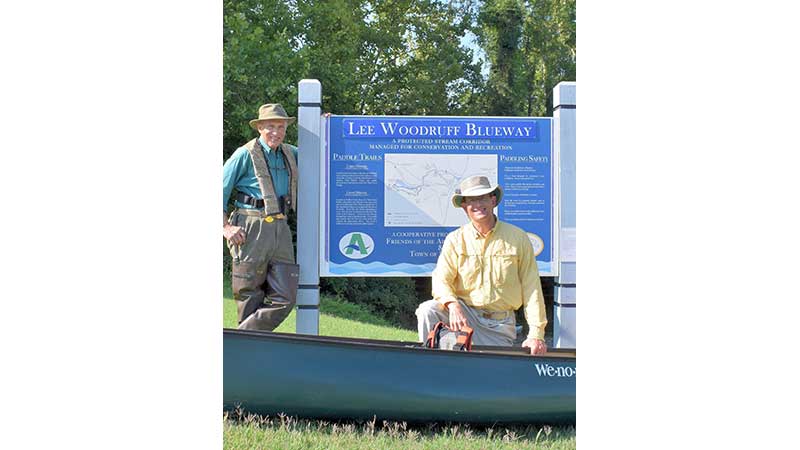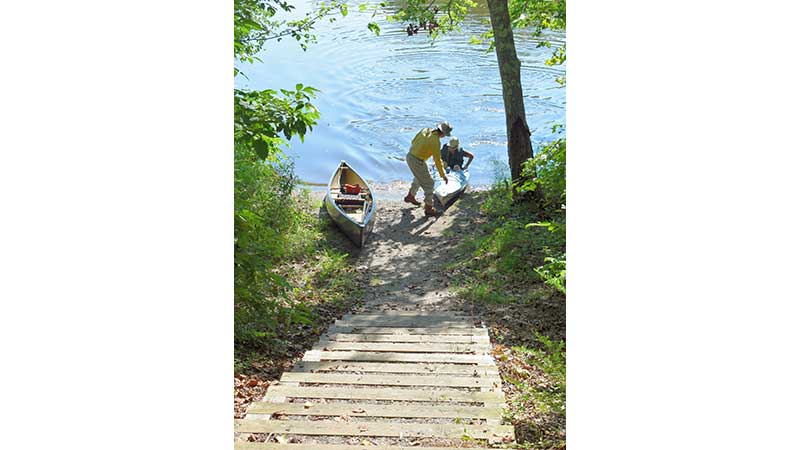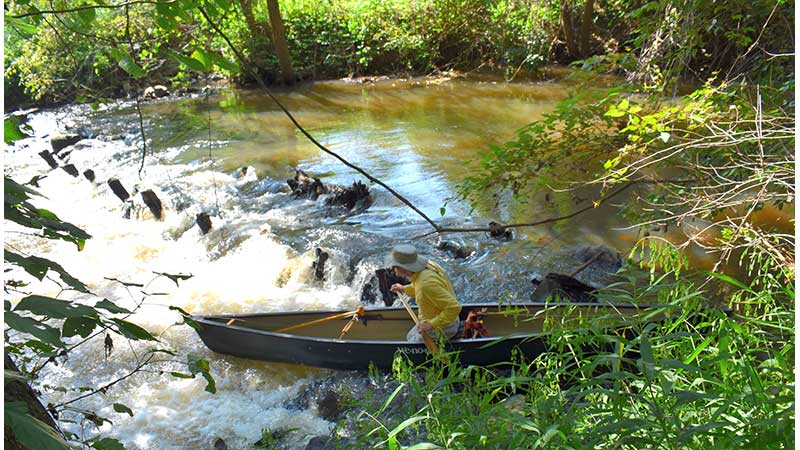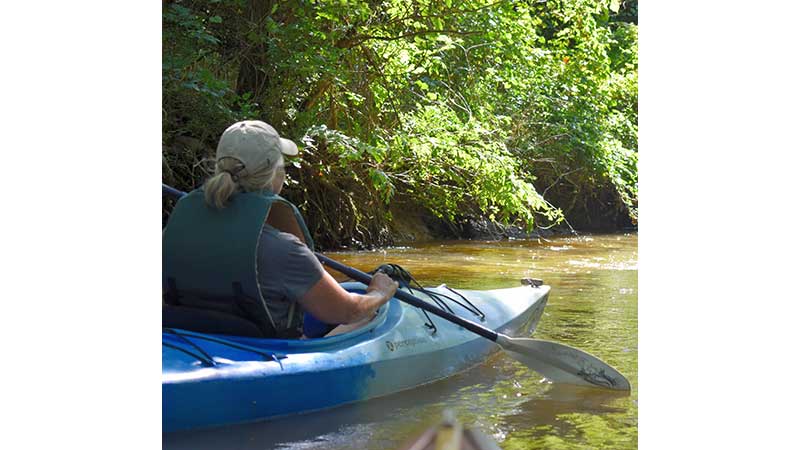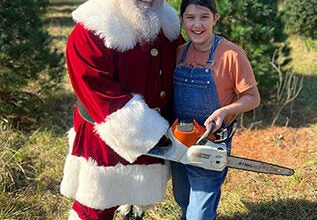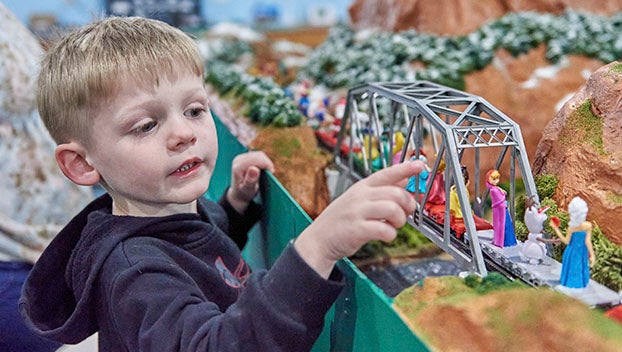Waterway fun — up close and personal
Published 6:00 am Monday, October 19, 2020
|
Getting your Trinity Audio player ready...
|
Story and photos by Marge Swayne
Working from home, the new norm these days, is not a problem for Lee Woodruff. He feels right at home on Farmville’s Blueway, the 4-mile water trail named in his honor.
“I’ve always loved the water,” Woodruff commented as he launched his canoe for one of his daily trips along the Blueway.
Woodruff grew up near the Little River in his hometown of Cadiz, Kentucky, where he enjoyed canoeing, fishing and catching crawfish, some as big as small lobsters.
“From an early age I just enjoyed being around water,” he added.
That love of the outdoors led Woodruff to a career in biology. In 1972 he moved to Virginia to teach biology at Richard Bland College in Petersburg, a position he held for 40 years.
When Woodruff and his wife Beth decided to move to Farmville in 2001, he was delighted to learn there was a river running through town. Starting with Wilck’s Lake, Woodruff began exploring paddling possibilities.
“One day after crossing the lake in my canoe, I decided to explore Buffalo Creek that runs just behind it,” he recalled. “I put my boat into Buffalo Creek and immediately encountered obstructions — there were logs everywhere.”
In spite of the logs and other obstructions in the way, Woodruff visualized a water trail starting at Wilck’s Lake and continuing down Buffalo Creek to the Appomattox River.
The Friends of the Appomattox River (FAR), a volunteer organization established in 1997, had thoughts along the same lines. Damien Fehrer, chairman of the Friends Blueway Committee, explained FAR’s project along the Appomattox on the lower Blueway.
“One of the original members of the Friends, Alecia Daves-Johnson, realized how a waterway could benefit the community,” he said. “In 1999, Alecia led a determined group of volunteers to restore and protect the riverbank adjacent to a bridge pier constructed by the Farmville and Powhatan Railroad over 100 years ago.”
Also in 1999, she coordinated cleanup efforts with a U.S. Navy Explosives Ordnance Demolition Team and the Department of Forestry to remove massive logjams.
As work progressed on the lower Blueway, Woodruff set to work on the upper portion around Wilck’s Lake and Buffalo Creek. His cleanup efforts started in earnest when the Friends purchased a chainsaw.
“FAR bought a Stihl chainsaw for me — that was the beginning of it,” Woodruff recalled with a smile. “I started going out on Buffalo Creek, usually by myself, to work on some little obstructions. I had waders, so I’d get out in the water, cut the logs in two and drag them out.”
While keeping up with Mother Nature was a challenge, it was something Woodruff enjoyed.
Fehrer recalled one of Woodruff’s cleanups that went above and beyond.
“On one occasion Lee took advantage of some low water levels to remove a large area of broken glass that was in the river,” Fehrer recalled. “He loaded so much glass into his canoe that he could no longer get into it and had to walk the boat downstream.”
“Lee’s the keeper of the Blueway,” FAR member Faye Green said. “He goes every day if the weather’s nice. He’s always working on a project — always has his saw and shears.”
After years of clearing and cleaning, the 4-mile Blueway opened to the public in 2014.
“The Friends of the Appomattox along with our partners and supporters have worked a long time on this project,” Fehrer commented during opening ceremonies on May 24, 2014.
Today the Blueway continues to offer outdoor adventure along with a bonus in today’s world — socially distanced stress relief. The modern world and its troubles seem to recede under the leafy canopy that arches across the river.
It is, in fact, “a world apart.”
“You have the feeling of being in complete wilderness back here,” Woodruff said.
In addition to the Blueway’s scenic appeal, Fehrer commented on the location and ease of access.
“I enjoy immersing myself in the out of doors without having to travel a long distance,” he said. “When you’re out here, you can really enjoy the solitude. It’s refreshing — just listening to the birds, leaves rustling in the trees, water moving against the rocks. Having it all so close means you can come spend an hour or half a day.”
While scenic views change with the season, there’s always something to see along the way. Birds and wildlife abound.
“I’ve seen deer, beaver, otter, owls, bald eagles, herons, osprey and belted kingfishers,” Woodruff noted.
“The first time I went on the Blueway, I couldn’t believe I was still in Farmville,” Green added. “It’s a wonderful place to take friends when they come to town.”
Recently she’s been taking her grandson on Blueway excursions.
“Jack’s just 10, but he’s picked up the natural movement of where to paddle and where to put the boat,” she said. “We both enjoy it.”
Green especially enjoys the botanical sights along the river. She pointed out the fire-engine-red cardinal flowers currently blooming along the river’s edge.
“In the springtime when bluebells are in bloom, whole sections along the river are covered in blue,” she said. “It’s gorgeous, and you’d never see it if you didn’t paddle down the river.”
Fehrer, who’s also a member of the Margaret Watson Bird Club, enjoys identifying birds as he floats down the river. Recently the Watson Bird Club added signage describing birds commonly seen along the Blueway.
“The Watson Bird Club put up nest boxes for the prothonotary warbler, a bird that likes to nest in dead trees in swampy areas,” Woodruff added.
Additionally in 2017, the bird club built a “flight deck” for bird watching and observing wildlife around Wilck’s Lake.
Many individuals and organizations, Fehrer noted, contributed to making the Blueway what it is today.
Historical sights noted in the Blueway brochure include a proposed junction canal, Native American dwelling mound, narrow-gauge railroad bridge pier, waterfront and canal, and a milldam added in 1838 to power Prince Edward Mill. A portion of the milldam, still visible today from Charley’s Waterfront Café, adds a touch paddling adventure to the final stretch of the trail.
A major partner in the Blueway project, Fehrer added, was the Town of Farmville.
“The town supported the Blueway project from its inception,” he said. “On numerous occasions the town provided us with personnel and equipment.”
In a name change proposed by the Friends, the Farmville Blueway became the Lee Woodruff Blueway last year.
Woodruff couldn’t be more pleased with the project that now bears his name.
“It’s a wonderful thing we have in the Blueway,” Woodruff concluded. “Farmville has just about anything a person might need. The way I see it, if Farmville doesn’t have it, I don’t need it.”


